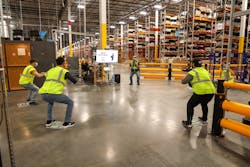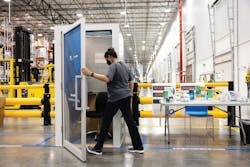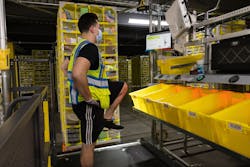Amazon, known for its Prime two-day delivery, is now focused on delivering health and wellness interventions to its employees.
The need couldn’t be more urgent.
2020 brought to a head multiple workforce issues—everything from COVID-19, mental health and addiction struggles, social injustices and systemic racism. And that’s in addition to persistent workplace concerns, such as reducing incidents of slips, trips and falls.
The past year and a half has been a busy time for Amazon, to say the least. Amazon’s global network of more than 175 warehouses, known as fulfillment centers, and extensive delivery infrastructure allowed customers to purchase essentials, and everything else, from the safety and comfort of their homes.
This increased demand drove record-setting growth and profits for the company. In Q4 2020, Amazon recorded its first-ever quarterly total revenue in excess of $100 billion, a record that it subsequently surpassed in Q1 and Q2 2021.
Revenue is not the only area where the company has seen massive growth. In 2020, Amazon’s global workforce grew by more than 50% from the previous year. Amazon now boasts a global workforce of 1.3 million, and a U.S. workforce of about 950,000. Those figures don't account for the hundreds of thousands of seasonal or temporary workers or third-party contractors. The company is now the second-largest private employer in the U.S. and is expected to surpass Walmart, the current leader, in a year or two.
That has presented a massive challenge for keeping Amazon workers safe, from new hire training to ongoing support for current employees, all the while trying to mitigate the spread of COVID-19.
Jeff Bezos, Amazon’s founder and executive chairman, acknowledged some of the company’s shortcomings in a March 5 letter to stakeholders. “Despite what we’ve accomplished, it’s clear to me that we need a better vision for our employees’ success,” he wrote. “We have always wanted to be Earth’s Most Customer-Centric Company. We won’t change that. It’s what got us here. But I am committing us to an addition. We are going to be Earth’s Best Employer and Earth’s Safest Place to Work.”
Bezos announced that in 2021 Amazon will invest more than $300 million into safety projects, including an initial $66 million to create technology that will help prevent collisions of forklifts and other types of industrial vehicles.
The motivation is simple, says Heather MacDougall, Amazon’s vice president of worldwide workplace health and safety. “Our employees are the heart and soul of our operations, so we’re working really hard every day to make sure, not only that they’re healthy and safe at work, but they feel deeply cared about, and they’re proud to work for Amazon,” she tells EHS Today.
Last year, Amazon spent $11.5 billion on COVID-19 safety measures. Some of those safety measures continue, and others are contingent upon COVID-19 cases and latest guidance from the Centers for Disease Control and Prevention (CDC). For example, Amazon announced in May that fully vaccinated workers no longer need to wear face masks unless mandated by local law; however, in August the company announced all warehouse employees, regardless of vaccine status, would need to resume wearing face masks. In July, the company announced it would stop testing workers for COVID-19 at its warehouses at the end of the month, citing the availability of vaccines and other free testing; however, the company could quickly and easily resume testing if needed since it built a lab and program in 2020.
Although Amazon is still navigating the pandemic, it is already setting its sights on other safety initiatives. Here is a detailed look at some of those efforts.
COVID-19 Vaccine Drives
Amazon is offering COVID-19 vaccines at more than 250 locations in 37 U.S. states and Canada. Frontline employees, contractors, member partners and, in some instances, their family members are eligible to receive vaccinations at the on-site drives, which typically last a day or two. As of late-May, the company said that more than 500,000 employees had access to these vaccine drives at fulfillment centers, sort centers, delivery stations, Amazon Web Services data centers and Whole Foods Market stores.
“We’re making it as easy as possible to get vaccinated,” MacDougall says. “As long as we continue to have employees who are not vaccinated and are seeking to be vaccinated, I think that we’ll continue these events.” She did not provide an estimate of how many people have elected to get vaccinated but says it is similar to the vaccination rate in the communities in which Amazon operates.
MacDougall says Amazon worked for months with state and local government and public health officials to procure the vaccines, which are administered by licensed health care providers. In its Q1 2021 earnings report, Amazon notes that “given the vaccination program’s progress in the U.S., it will soon expand to frontline employees in other countries.”
All current U.S. hourly, non-exempt employees receive an $80 benefit for getting fully vaccinated, whether on-site or off-site, and employees can take unpaid time off if they experience any vaccine side effects. Amazon is offering a $100 benefit for new hires who show proof of their COVID-19 vaccination.
WorkingWell
Amazon is rolling out WorkingWell, a program it piloted in 2020, to help employees focus on their physical and mental well-being. The program is expected to expand to all of Amazon’s U.S. operations sites by the end of 2021 and then launch in other countries. MacDougall described three of its components:
- Health & Safety Huddles are focused on engaging employees on body mechanics, wellness topics and ongoing safety training. Leaders gather with a small group of employees (in a socially distant way) to watch short, interactive videos on a different topic each month, such as gripping and handling, stretching, lifting, pushing and proper nutrition.
- Mind & Body Moments provides hourly visual prompts to help employees recharge, reenergize, and reduce muscle and mental fatigue. Whether they’re picking or stowing at a screen or using a handheld scanner, employees are guided through scientifically proven mental and physical activities lasting 30-60 seconds that can include stretching, breathing exercises or reflecting.
- AmaZen guides employees through interactive mindfulness practices in enclosed kiosks located around their facilities. Employees can visit AmaZen stations while on break or before or after their shifts to watch wellness activities, guided meditations, positive affirmations and view calming scenes and sounds. MacDougall says based on positive employee feedback, the company is looking to develop an app for WorkingWell so employees can access AmaZen content at home.
WorkingWell is intended to help Amazon reach its goal of reducing recordable incident rates by 50% by 2025. In his stakeholder letter, Bezos wrote that about 40% of Amazon’s work-related injuries are related to musculoskeletal disorders (MSDs). The company, known for its use of technology, is also developing algorithms to automate staffing schedules to rotate employees among jobs that use different muscle-tendon groups to decrease repetitive motion and help protect employees from MSD risks.
Resources for Living
Also in May, Amazon launched a new program called Resources for Living that provides employees greater access to mental health care.
“We know [mental health care] is really important to our employees as we continue to navigate the challenges of everyday life and this pandemic,” MacDougall says. “[Resources for Living] really seeks to remove common barriers to getting help and focusing on how health and safety is really our Number 1 priority, and that includes not just physical safety, but mental health as well.”
As part of the program, every U.S. employee, their family and their household will receive free one-on-one counseling sessions—three sessions per person, per topic. Amazon will fund up to 24 million counseling sessions per year, available in person or by phone, video or text.
The program also includes crisis and suicide-prevention support available 24/7; interactive self-care programs, including self-assessments and a stress resource center; and a self-paced app that offers computerized Cognitive Behavior Therapy, mindfulness resources and support for a range of mental health and wellness issues.
Workplace Injury Partnership
In June, Amazon and the National Safety Council (NSC) announced a five-year partnership to invent new ways to prevent MSDs across a variety of industries.
This collaboration is possible because of Amazon’s $12 million contribution, the largest in NSC’s history, and includes five key components: establishing an advisory council, conducting research using the latest technologies, providing small business and university grants, hosting innovation challenges and launching the MSD Pledge. The pledge is an invitation for other companies to track injuries and develop programs to prevent MSDs.
“Nothing is more important than the safety of our employees, and this partnership will allow us to dive deep into the best way to reduce MSDs,” MacDougall said in a press release.
During a media briefing, MacDougall said that Amazon’s system of performance metrics for how fast employees work, referred to as rate, will not change.
“Safety and performance targets can go hand in hand, and that will continue to be the case,” she said.




